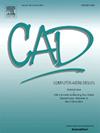Adaptive gap closing for complex triangular mesh repair using geometric and topological characteristics
IF 3.1
3区 计算机科学
Q2 COMPUTER SCIENCE, SOFTWARE ENGINEERING
引用次数: 0
Abstract
Gaps are prevalent defects in triangular meshes, often arising from various sources such as surface scanning and CAD model generation. Despite their significance, the automatic repair of complex gaps has received limited attention compared to other mesh imperfections. This study presents a novel surface-based gap-closing method for triangular mesh repair, leveraging both local geometric and topological characteristics to robustly match and merge gap boundaries. The proposed approach first employs a global–local vertex merging procedure with adaptive tolerances to eliminate duplicate vertices and simplify complex gaps. Subsequently, gaps are identified and classified into connected and disconnected types based on their topological and geometric features. For each detected gap, a non-iterative closing procedure is applied, simultaneously matching and merging all boundary vertices. An adaptive scheme is introduced to determine the geometric tolerance for vertex matching, ensuring the effective preservation of the original geometric shape. Extensive numerical experiments on a large dataset of discrete models demonstrate the effectiveness and robustness of the proposed method in closing both connected and disconnected gaps.
基于几何和拓扑特征的复杂三角形网格自适应闭合修复
在三角形网格中,由于曲面扫描和CAD模型生成等原因,产生了许多缺陷。尽管具有重要意义,但与其他网格缺陷相比,复杂间隙的自动修复受到的关注有限。本文提出了一种新的基于表面的三角形网格修补方法,利用局部几何和拓扑特征对缝隙边界进行鲁棒匹配和合并。该方法首先采用具有自适应容差的全局-局部顶点合并过程,消除重复顶点,简化复杂间隙。然后,根据其拓扑和几何特征对间隙进行识别,并将其分为连通型和非连通型。对于每个检测到的间隙,应用非迭代闭合过程,同时匹配和合并所有边界顶点。引入了一种自适应方案来确定顶点匹配的几何公差,保证了原始几何形状的有效保留。在大量离散模型数据集上进行的大量数值实验证明了该方法在关闭连接和不连接间隙方面的有效性和鲁棒性。
本文章由计算机程序翻译,如有差异,请以英文原文为准。
求助全文
约1分钟内获得全文
求助全文
来源期刊

Computer-Aided Design
工程技术-计算机:软件工程
CiteScore
5.50
自引率
4.70%
发文量
117
审稿时长
4.2 months
期刊介绍:
Computer-Aided Design is a leading international journal that provides academia and industry with key papers on research and developments in the application of computers to design.
Computer-Aided Design invites papers reporting new research, as well as novel or particularly significant applications, within a wide range of topics, spanning all stages of design process from concept creation to manufacture and beyond.
 求助内容:
求助内容: 应助结果提醒方式:
应助结果提醒方式:


